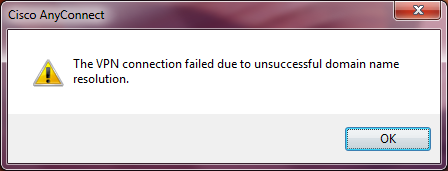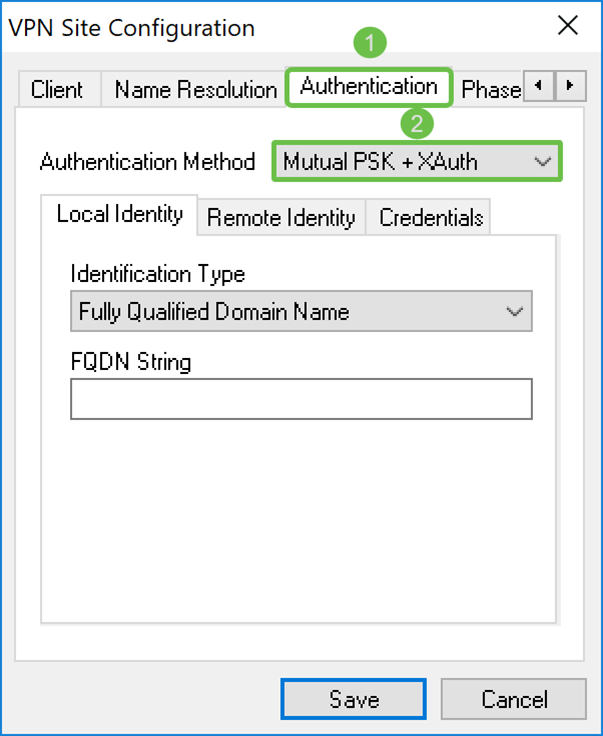- Cisco Anyconnect Could Not Connect To Server
- Cisco Anyconnect Unsuccessful Domain Name Resolution Windows 10 Download
- Cisco AnyConnect VPN Client
Just switched from Viasat to a Hughes business account. This problem did not exist with Viasat and does not exist when connected to the internet via my hotspot. When I connect to VPN while connected to Hughes, I have no DNS resolution into my AD domain. RDP fails with cannot find the computer, ping fails with cannot find host. Download the Cisco AnyConnect VPN for Windows installer. Double-click the InstallAnyConnect.exe file. When a message saying the Cisco AnyConnect client has been installed, click OK. Connect to the Stanford VPN. Launch the Cisco AnyConnect Secure Mobility Client client. The VPN connection failed due to unsuccessful domain name resolution when I entered the domain name of router's interface g0/1 from nslookup (server 8.8.8.8). Updated2: I could do forward nslookup but reverse lookup (domain name - IP) returns failed. Is it a problem? Update3: In router's config: ip name-server 8.8.8.8.
Cisco Anyconnect Could Not Connect To Server
Windows 8 users can read our Cisco VPN Client Fix for Windows 8 Operating System. Windows 10 32bit & 64bit Anniversary Update 1607 users can read our Fix Cisco VPN Client Break After Windows 10 Anniversary Update 1607. How to Install Cisco VPN Client on Windows 10 (New installations or O/S upgrades). Domain: Enter the fully qualified domain name (FQDN) or a DNS suffix to apply the rule. You can also enter a period (.) at the beginning for a DNS suffix. For example, enter contoso.com or.allcontososubdomains.com. DNS servers: Enter the IP address or DNS server that resolves the domain. For example, enter 10.0.0.3 or vpn.contoso.com.
[solved] how to resolve the Cisco Anyconnect error message “VPN connection failed due to unsuccessful domain name resolution”
The above message is a very common message caused by the local internet provider DNS resolution failure and cane be fixed very easily.
below is the error message that you may get when trying to connect to the VPN while connected to the home internet.
You will see that Cisco Anyconnect displays an error message where it is not able to connect to the VPN host using the hostname.
The first thing you will need to confirm is if the DNS resolution is working and in order to confirm that you will need to run the command prompt.
Launch the command prompt by going “start” “run” type “cmd” – see the screenshot for reference.
You can test the resolution by pinging espn.com.
- type “ping” and you can see Ping espn.com is not resolving.
- nslookup for cnn.com does not resolve and shows a loop back address as a dns server.
One good place to see more logs is by going to the gear icon on the Cisco Anyconnect. see the screenshot below for reference.
Go to the VPN tab and message history and you can see how many times, the client tried to connect and failed..
Start the command prompt again to test the DNS resolution.

This time use the DNS lookup using the google DNS server and you will see a response and that confirms that is the DNS server.

You can update the DNS server by manually adding the google DNS server for a temporary fix until your internet provider fixes the issue.
Thanks for ready this.
| This article refers to the Cisco AnyConnect VPN. If you're looking for information on the Prisma Access VPN Beta that uses the GobalConnect app, see: Prisma Access VPN Landing Page. If you're not sure which service you're using, see: How do I know if I'm using the Cisco AnyConnect VPN or the Prisma Access VPN? |
Problem
You are trying to connect to MIT's VPN on vpn.mit.edu, but get an error:
Cisco Anyconnect Unsuccessful Domain Name Resolution Windows 10 Download

Cisco AnyConnect VPN Client
The VPN connection failed due to unsuccessful domain name resolution.

Solution
First, make sure that the problem only affects the Cisco VPN app. Test vpn.mit.edu with other tools such as a web browser, or 'ping' the hostname.
The cause is not fully known, but this is seen more frequently when people are using Google Public DNS (DNS servers 8.8.8.8 and 8.8.4.4)
- Try using another DNS server, such as your ISP's DNS server
- Try sending some pings to vpn.mit.edu before connecting; these can help cache the IP address in your DNS cache.
- Wait a few minutes and try connecting again; the connection can work if you try again later.
